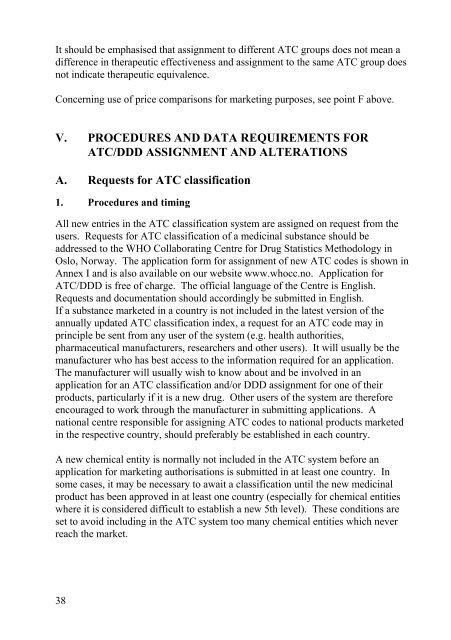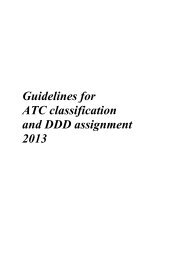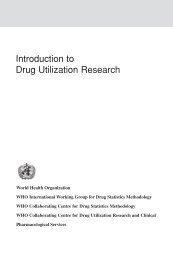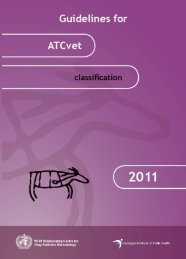Guidelines for ATC classification and DDD assignment - WHOCC
Guidelines for ATC classification and DDD assignment - WHOCC
Guidelines for ATC classification and DDD assignment - WHOCC
Create successful ePaper yourself
Turn your PDF publications into a flip-book with our unique Google optimized e-Paper software.
It should be emphasised that <strong>assignment</strong> to different <strong>ATC</strong> groups does not mean a<br />
difference in therapeutic effectiveness <strong>and</strong> <strong>assignment</strong> to the same <strong>ATC</strong> group does<br />
not indicate therapeutic equivalence.<br />
Concerning use of price comparisons <strong>for</strong> marketing purposes, see point F above.<br />
V. PROCEDURES AND DATA REQUIREMENTS FOR<br />
<strong>ATC</strong>/<strong>DDD</strong> ASSIGNMENT AND ALTERATIONS<br />
A. Requests <strong>for</strong> <strong>ATC</strong> <strong>classification</strong><br />
1. Procedures <strong>and</strong> timing<br />
All new entries in the <strong>ATC</strong> <strong>classification</strong> system are assigned on request from the<br />
users. Requests <strong>for</strong> <strong>ATC</strong> <strong>classification</strong> of a medicinal substance should be<br />
addressed to the WHO Collaborating Centre <strong>for</strong> Drug Statistics Methodology in<br />
Oslo, Norway. The application <strong>for</strong>m <strong>for</strong> <strong>assignment</strong> of new <strong>ATC</strong> codes is shown in<br />
Annex I <strong>and</strong> is also available on our website www.whocc.no. Application <strong>for</strong><br />
<strong>ATC</strong>/<strong>DDD</strong> is free of charge. The official language of the Centre is English.<br />
Requests <strong>and</strong> documentation should accordingly be submitted in English.<br />
If a substance marketed in a country is not included in the latest version of the<br />
annually updated <strong>ATC</strong> <strong>classification</strong> index, a request <strong>for</strong> an <strong>ATC</strong> code may in<br />
principle be sent from any user of the system (e.g. health authorities,<br />
pharmaceutical manufacturers, researchers <strong>and</strong> other users). It will usually be the<br />
manufacturer who has best access to the in<strong>for</strong>mation required <strong>for</strong> an application.<br />
The manufacturer will usually wish to know about <strong>and</strong> be involved in an<br />
application <strong>for</strong> an <strong>ATC</strong> <strong>classification</strong> <strong>and</strong>/or <strong>DDD</strong> <strong>assignment</strong> <strong>for</strong> one of their<br />
products, particularly if it is a new drug. Other users of the system are there<strong>for</strong>e<br />
encouraged to work through the manufacturer in submitting applications. A<br />
national centre responsible <strong>for</strong> assigning <strong>ATC</strong> codes to national products marketed<br />
in the respective country, should preferably be established in each country.<br />
A new chemical entity is normally not included in the <strong>ATC</strong> system be<strong>for</strong>e an<br />
application <strong>for</strong> marketing authorisations is submitted in at least one country. In<br />
some cases, it may be necessary to await a <strong>classification</strong> until the new medicinal<br />
product has been approved in at least one country (especially <strong>for</strong> chemical entities<br />
where it is considered difficult to establish a new 5th level). These conditions are<br />
set to avoid including in the <strong>ATC</strong> system too many chemical entities which never<br />
reach the market.<br />
38





